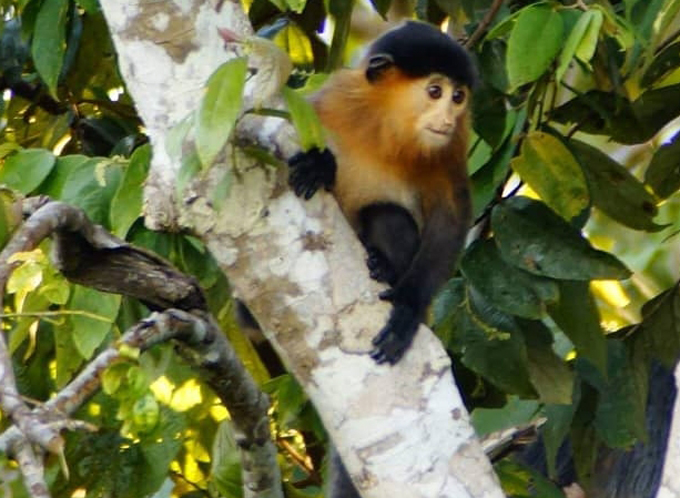Six years ago, tour guide Brenden Miles was traveling down the Kinabatangan River in the Malaysian part of Borneo, when he spotted an odd-looking primate he had never seen before. He snapped a few pictures of the strange monkey and, on reaching home, checked his images.
“At first, I thought it could be a morph of the silvered leaf monkey,” meaning a member of the species with rare color variation, Miles says. But then he noticed other little details. “Its nose was long like that of a proboscis monkey, and its tail was thicker than that of a silvered leaf [monkey],” he says. He posted a picture of the animal on Facebook and forgot all about it.
Now, an analysis of that photo and others suggests that the “mystery monkey” is a hybrid of two distantly related primate species that share the same fragmented habitat.
 In 2016, tour guide Brenden Miles took this photo of a young monkey in the Malaysian part of Borneo. The animal may be a hybrid of two distantly related types of primates.B. Miles
In 2016, tour guide Brenden Miles took this photo of a young monkey in the Malaysian part of Borneo. The animal may be a hybrid of two distantly related types of primates.B. Miles
The putative offspring was produced when a male proboscis monkey (Nasalis larvatus) mated with a female silvered leaf monkey (Trachypithecus cristatus), researchers suggest April 26 in the International Journal of Primatology. And that conclusion has the scientists worried about the creature’s parent species.
Hybridization between closely related organisms has been observed in captivity and occasionally in the wild (SN: 7/23/21). “But hybridization across genera, that’s very rare,” says conservation practitioner Ramesh Boonratana, the regional vice-chair for Southeast Asia for the International Union for Conservation of Nature’s primate specialist group.
Severe habitat loss, fragmentation and degradation caused by expanding palm oil plantations along the Kinabatangan River could explain how the possible hybrid came to be, says primatologist Nadine Ruppert.
“Different species — even from the same genus — when they share a habitat, they may interact with each other, but they may usually not mate. This kind of cross-genera hybridization happens only when there is some ecological pressure,” says Ruppert, of the Universiti Sains Malaysia in Penang Island.
The state of Sabah, where Kinabatangan River is located, lost about 40 percent of its forest cover from 1973 to 2010, with logging and palm oil plantations being the main drivers of deforestation, a study in 2014 found.

Sign Up For the Latest from Science News
Headlines and summaries of the latest Science News articles, delivered to your inbox
Client key* E-mail Address* Go
Thank you for signing up!
There was a problem signing you up.
“In certain areas, both [monkey] species are confined to small forest fragments along the river,” Ruppert says. This leads to competition for food, mates and other resources. “The animals cannot disperse and, in this case, the male of the larger species — the proboscis monkey — can easily displace the male silvered leaf monkey.”
Since 2016, there have been some more documented sightings of the mystery monkey, though these have been sporadic. The infrequent sightings and the COVID-19 pandemic has, for now, prevented researchers from gathering fecal samples for genetic analysis to reveal the monkey’s identity. Instead, Ruppert and colleagues compared images of the possible hybrid with those of the parent species, both visually as well as by using limb ratios. “If the individual was from one of the two parent species, all its measurements would be similar to that of one species,” Ruppert says. “But that is not the case with this animal.”
A photograph of a male proboscis monkey mating with a female silvered leaf monkey, along with anecdotes from boat operators and tour guides about a single male proboscis monkey hanging around a troop of female silvered leaf monkeys, has added further weight to the researchers’ conclusion.
The mystery monkey is generating a lot of excitement in the area, but Ruppert is concerned for the welfare of both proposed parent species. The International Union for Conservation of Nature classifies proboscis monkeys as endangered and silvered leaf monkeys as vulnerable. “The hybrid is gorgeous, but we don’t want to see more of them,” Ruppert says. “Both species should have a large enough habitat, dispersal opportunities and enough food to conduct their natural behaviors in the long term.”
Increasing habitat loss or fragmentation in Borneo and elsewhere as a result of changing land uses or climate change could lead to more instances of mating — or at least, attempts at mating — between species or even genera, Boonratana says.
The mystery monkey was last photographed in September of 2020 with swollen breasts and holding a baby, suggesting that the animal is a fertile female. That’s another surprising development, the researchers say, because most hybrids tend to be sterile.

